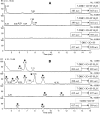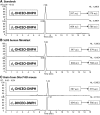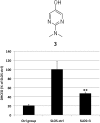An oxysterol biomarker for 7-dehydrocholesterol oxidation in cell/mouse models for Smith-Lemli-Opitz syndrome
- PMID: 21402677
- PMCID: PMC3090243
- DOI: 10.1194/jlr.M014498
An oxysterol biomarker for 7-dehydrocholesterol oxidation in cell/mouse models for Smith-Lemli-Opitz syndrome
Abstract
The level of 7-dehydrocholesterol (7-DHC) is elevated in tissues and fluids of Smith-Lemli-Opitz syndrome (SLOS) patients due to defective 7-DHC reductase. Although over a dozen oxysterols have been identified from 7-DHC free radical oxidation in solution, oxysterol profiles in SLOS cells and tissues have never been studied. We report here the identification and complete characterization of a novel oxysterol, 3β,5α-dihydroxycholest-7-en-6-one (DHCEO), as a biomarker for 7-DHC oxidation in fibroblasts from SLOS patients and brain tissue from a SLOS mouse model. Deuterated (d₇)-standards of 7-DHC and DHCEO were synthesized from d₇-cholesterol. The presence of DHCEO in SLOS samples was supported by chemical derivatization in the presence of d₇-DHCEO standard followed by HPLC-MS or GC-MS analysis. Quantification of cholesterol, 7-DHC, and DHCEO was carried out by isotope dilution MS with the d₇-standards. The level of DHCEO was high and correlated well with the level of 7-DHC in all samples examined (R = 0.9851). Based on our in vitro studies in two different cell lines, the mechanism of formation of DHCEO that involves 5α,6α-epoxycholest-7-en-3β-ol, a primary free radical oxidation product of 7-DHC, and 7-cholesten-3β,5α,6β-triol is proposed. In a preliminary test, a pyrimidinol antioxidant was found to effectively suppress the formation of DHCEO in SLOS fibroblasts.
Figures








Similar articles
-
Antioxidant supplementation ameliorates molecular deficits in Smith-Lemli-Opitz syndrome.Biol Psychiatry. 2014 Feb 1;75(3):215-22. doi: 10.1016/j.biopsych.2013.06.013. Epub 2013 Jul 26. Biol Psychiatry. 2014. PMID: 23896203 Free PMC article.
-
DHCEO accumulation is a critical mediator of pathophysiology in a Smith-Lemli-Opitz syndrome model.Neurobiol Dis. 2012 Mar;45(3):923-9. doi: 10.1016/j.nbd.2011.12.011. Epub 2011 Dec 11. Neurobiol Dis. 2012. PMID: 22182693 Free PMC article.
-
Novel oxysterols observed in tissues and fluids of AY9944-treated rats: a model for Smith-Lemli-Opitz syndrome.J Lipid Res. 2011 Oct;52(10):1810-20. doi: 10.1194/jlr.M018366. Epub 2011 Aug 4. J Lipid Res. 2011. PMID: 21817059 Free PMC article.
-
Smith-Lemli-Opitz syndrome: Clinical, biochemical, and genetic insights with emerging treatment opportunities.Genet Med. 2025 Jul;27(7):101450. doi: 10.1016/j.gim.2025.101450. Epub 2025 Apr 29. Genet Med. 2025. PMID: 40314187 Review.
-
RSH/Smith-Lemli-Opitz syndrome: a multiple congenital anomaly/mental retardation syndrome due to an inborn error of cholesterol biosynthesis.Mol Genet Metab. 2000 Sep-Oct;71(1-2):163-74. doi: 10.1006/mgme.2000.3069. Mol Genet Metab. 2000. PMID: 11001807 Review.
Cited by
-
A perspective on free radical autoxidation: the physical organic chemistry of polyunsaturated fatty acid and sterol peroxidation.J Org Chem. 2013 Apr 19;78(8):3511-24. doi: 10.1021/jo4001433. Epub 2013 Apr 9. J Org Chem. 2013. PMID: 23445181 Free PMC article.
-
Antioxidant supplementation ameliorates molecular deficits in Smith-Lemli-Opitz syndrome.Biol Psychiatry. 2014 Feb 1;75(3):215-22. doi: 10.1016/j.biopsych.2013.06.013. Epub 2013 Jul 26. Biol Psychiatry. 2014. PMID: 23896203 Free PMC article.
-
DHCEO accumulation is a critical mediator of pathophysiology in a Smith-Lemli-Opitz syndrome model.Neurobiol Dis. 2012 Mar;45(3):923-9. doi: 10.1016/j.nbd.2011.12.011. Epub 2011 Dec 11. Neurobiol Dis. 2012. PMID: 22182693 Free PMC article.
-
Competition H(D) kinetic isotope effects in the autoxidation of hydrocarbons.J Am Chem Soc. 2015 Jan 14;137(1):94-7. doi: 10.1021/ja511434j. Epub 2014 Dec 31. J Am Chem Soc. 2015. PMID: 25533605 Free PMC article.
-
Pharmacological cholesterol depletion disturbs ciliogenesis and ciliary function in developing zebrafish.Commun Biol. 2019 Jan 29;2:31. doi: 10.1038/s42003-018-0272-7. eCollection 2019. Commun Biol. 2019. PMID: 30729178 Free PMC article.
References
-
- Irons M., Elias E. R., Salen G., Tint G. S., Batta A. K. 1993. Defective cholesterol biosynthesis in Smith-Lemli-Opitz syndrome. Lancet. 341: 1414. - PubMed
-
- Tint G. S., Irons M., Elias E. R., Batta A. K., Frieden R., Chen T. S., Salen G. 1994. Defective cholesterol biosynthesis associated with the Smith-Lemli-Opitz syndrome. N. Engl. J. Med. 330: 107–113. - PubMed
-
- Fitzky B. U., Moebius F. F., Asaoka H., Waage-Baudet H., Xu L., Xu G., Maeda N., Kluckman K., Hiller S., Yu H., et al. 2001. 7-Dehydrocholesterol-dependent proteolysis of HMG-CoA reductase suppresses sterol biosynthesis in a mouse model of Smith-Lemli-Opitz/RSH syndrome. J. Clin. Invest. 108: 905–915. - PMC - PubMed
-
- Krakowiak P. A., Nwokoro N. A., Wassif C. A., Battaile K. P., Nowaczyk M. J., Connor W. E., Maslen C., Steiner R. D., Porter F. D. 2000. Mutation analysis and description of sixteen RSH/Smith-Lemli-Opitz syndrome patients: polymerase chain reaction-based assays to simplify genotyping. Am. J. Med. Genet. 94: 214–227. - PubMed
-
- Waterham H. R. 2002. Inherited disorders of cholesterol biosynthesis. Clin. Genet. 61: 393–403. - PubMed
Publication types
MeSH terms
Substances
Grants and funding
LinkOut - more resources
Full Text Sources
Molecular Biology Databases
Research Materials
Miscellaneous

